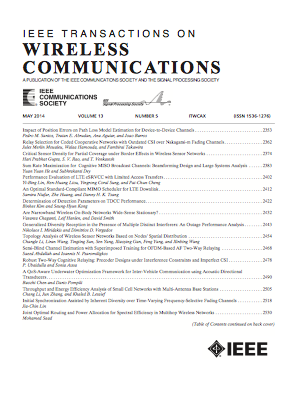无空间频谱亚太赫兹网络:大规模案例研究
IF 10.7
1区 计算机科学
Q1 ENGINEERING, ELECTRICAL & ELECTRONIC
引用次数: 0
摘要
本文研究了密集分布接入点(ap)为众多用户服务的大规模无蜂窝网络。无蜂窝网络作为一种很有前途的下一代网络架构,能够实现超可靠的连接和最小的衰落/阻塞,这对毫米波和太赫兹传输非常有利。然而,传统的波束管理方法在一个单元中使用大型相控阵,在较高的频率下非常耗时,并且当在无单元系统中部署大量协调ap时可能会恶化。为了解决这一问题,通过将传播角与频率耦合,建立了具有漏波天线的空间频谱无蜂窝网络。利用这种空间-频谱耦合效应可以显著降低该方向的波束训练开销。在考虑的大规模空间频谱无蜂窝网络中,利用交叉熵法和混合模型之间的关系,提出了一种新的亚太赫兹频段子信道分配方案。由于初始接入和AP聚类在实现可扩展的大规模无蜂窝网络中起着关键作用,因此提出了一种分层AP聚类方案,使初始接入和簇的形成联合,该方案具有自适应能力,无需初始化AP簇的数量。在AP集群化之后,设计了子信道分配方案来管理AP集群间的干扰。数值结果证实了所提方案的有效性,并表明除了子信道分配之外,AP聚类也会对亚太赫兹频段的大规模无蜂窝网络性能产生很大影响。本文章由计算机程序翻译,如有差异,请以英文原文为准。
Spatial-Spectral Cell-Free Sub-Terahertz Networks: A Large-Scale Case Study
This paper studies the large-scale cell-free networks where dense distributed access points (APs) serve many users. As a promising next-generation network architecture, cell-free networks enable ultra-reliable connections and minimal fading/blockage, which are much favorable to the millimeter wave and terahertz transmissions. However, conventional beam management with large phased arrays in a cell is very time-consuming in the higher-frequencies, and could be worsened when deploying a large number of coordinated APs in the cell-free systems. To tackle this challenge, the spatial-spectral cell-free networks with the leaky-wave antennas are established by coupling the propagation angles with frequencies. The beam training overhead in this direction can be significantly reduced through exploiting such spatial-spectral coupling effects. In the considered large-scale spatial-spectral cell-free networks, a novel subchannel allocation solution at sub-terahertz bands is proposed by leveraging the relationship between cross-entropy method and mixture model. Since initial access and AP clustering play a key role in achieving scalable large-scale cell-free networks, a hierarchical AP clustering solution is proposed to make the joint initial access and cluster formation, which is adaptive and has no need to initialize the number of AP clusters. After AP clustering, a subchannel allocation solution is devised to manage the interference between AP clusters. Numerical results are presented to confirm the efficiency of the proposed solutions and indicate that besides subchannel allocation, AP clustering can also have a big impact on the large-scale cell-free network performance at sub-terahertz bands.
求助全文
通过发布文献求助,成功后即可免费获取论文全文。
去求助
来源期刊
CiteScore
18.60
自引率
10.60%
发文量
708
审稿时长
5.6 months
期刊介绍:
The IEEE Transactions on Wireless Communications is a prestigious publication that showcases cutting-edge advancements in wireless communications. It welcomes both theoretical and practical contributions in various areas. The scope of the Transactions encompasses a wide range of topics, including modulation and coding, detection and estimation, propagation and channel characterization, and diversity techniques. The journal also emphasizes the physical and link layer communication aspects of network architectures and protocols.
The journal is open to papers on specific topics or non-traditional topics related to specific application areas. This includes simulation tools and methodologies, orthogonal frequency division multiplexing, MIMO systems, and wireless over optical technologies.
Overall, the IEEE Transactions on Wireless Communications serves as a platform for high-quality manuscripts that push the boundaries of wireless communications and contribute to advancements in the field.

 求助内容:
求助内容: 应助结果提醒方式:
应助结果提醒方式:


